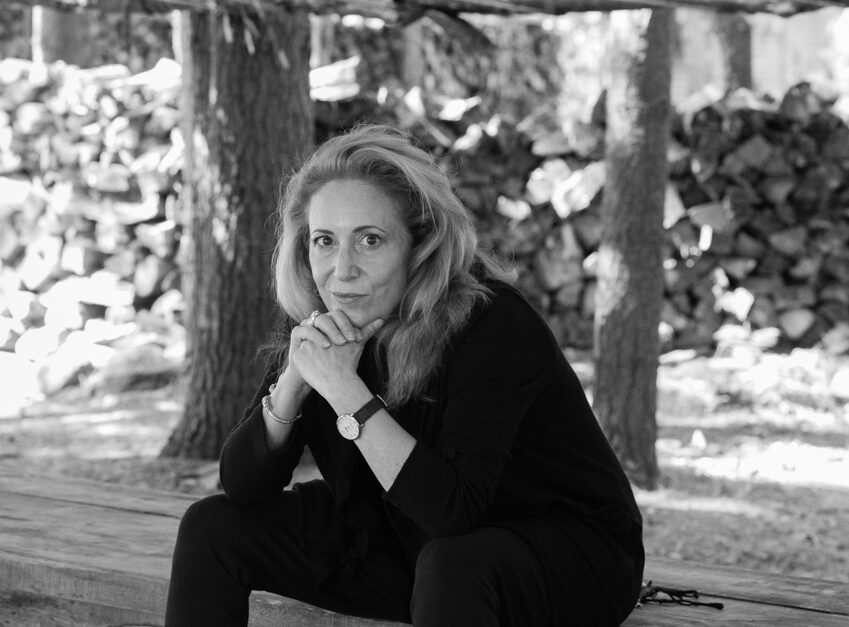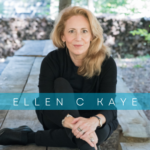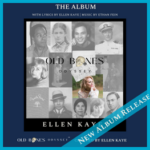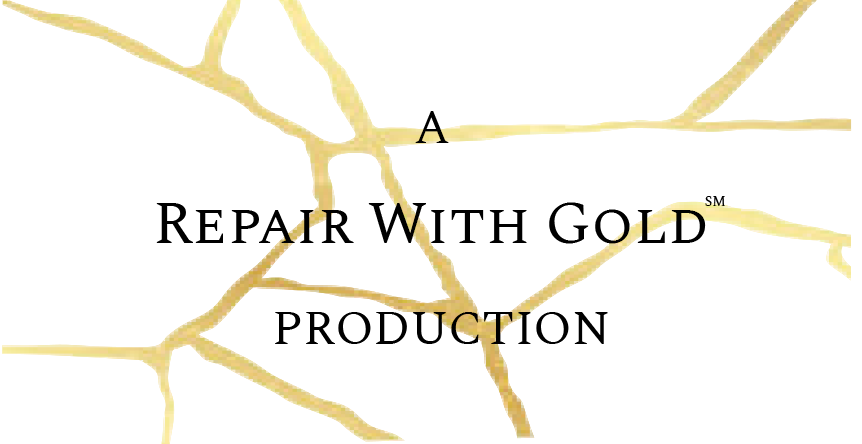CHAPTER I
Repair With Gold
Song Stories
Album Liner Notes
In this series of Song Stories we’re taking you behind the scenes of each song.
We’re starting with Chapter 1 – Old Bones Odyssey and our first song on the album Repair With Gold.
Coming soon: we’re creating a podcast that dives deeper into the stories and history behind our songs.

Listen
Videos
Repair With Gold Playlist
Lyrics
Repair With Gold
“Shine a light, shine a light on the broken people,
shine a light, shine a light on the broken world
be a mender of a broken world”
-Lyrics/Ellen Kaye
Ellen Kaye – Lead Vocal
Ethan Fein –Guitar
Diane Monroe – Violin
Andrew Drelles – Bass Clarinet
Koa Ho – Upright bass
Perry Cavari – Drums
Jackie Presti – Backing Vocals
Soara-Joye Ross – Backing Vocals
© 2022 Ellen C Kaye and Ethan Fein. All rights reserved.
Our world is hidden
We are hidden to ourselves
To each other
But the sparks of light
Lie in wait
Inside us all
Seams of gold
A lovely porcelain bowl
Made of earth and dust
Passed down from hand to hand
From life to life, home to home
Seams of gold in a window sill
Lit by the sun
A breeze blows by
Generations come and go
Seams of gold
Winds blow in from the cold
Made of smoke and dust
Passed down from hand to hand
From life to life, heart to heart
Seams of gold in a window sill
Broken in two
The years sweep by
Generations come and go
Veins of gold fill the cracks of what’s been shattered
Veins of gold are the scars of who we are
Only hearts can see what’s hidden
Only hearts can see the light
Shine a light, shine a light on the broken pieces
Shine a light, shine a light on the hidden scars
Shine a light, shine a light on what’s forgotten
Take the broken pieces and change the world
Seams of gold
A spirit flows through the bowl
Made of flames and dust
Passed down from hand to hand
From life to life, home to home
Seams of gold in a window sill
Lit by the moon
The world blows by
Generations come and go
Seams of gold
More precious now than before
Made of shards and dust
Passed down from hand to hand
From life to life, heart to heart
Seams of gold in a window sill
Lit by the stars
A dream flies by
Generations come and go
Sparks of light, burning up inside us
Hiding deep, way beyond our sight
Only hearts can see what’s hidden
Only hearts can see the light
Shine a light, shine a light on the broken pieces
Shine a light, shine a light on the hidden scars
Shine a light, shine a light on what’s forgotten
Take the broken pieces and change the world
Seams of gold
Tell the story you know
Made of fire and light
Passed down from hand to hand
From life to life, home to home
Seams of gold in a window sill
Lit by your soul
Our lives blaze by
Generations come and go
Seams of gold, seams of gold for our broken peoples
Seams of gold, seams of gold for our broken world
Seams of gold from the light that shines within us
Seams of gold will repair the world
Shine a light, shine a light on the broken peoples
Shine a light, shine a light on the broken world
Shine a light, shine a light on the broken pieces
Your seams of gold will mend the world
Find the light, find the light in the broken pieces
Find the light, find the light that will change the world
Find the light, find the light that lies within you
Take the broken pieces and change the world
Be a mender of a broken world
Ellen C Kaye – Lyrics
Ethan Fein – Music
Recorded/Mixed/Mastered by Bill Moss
Samurai Hotel Recording Studio – Queens, New York
Ellen C Kaye, Ethan Fein, Bill Moss, Alan Joseph–Producers
(c) 2023 A Repair With Gold LLC SM Production. All rights reseved.
The Story
Repair With Gold
“…what’s broken is the story,
it’s the beauty of the object,
of the person, of the life.”
-Ellen Kaye
“Repair With Gold” is so many years in the making. This song holds the ideas for all our work.
A few years ago at least, Naomi Fein, Ethan’s sister, said “Your Old Bones project makes me think of Tikkun Olam.” I’d never heard of it so I looked it up. On my first search I found that it was a Hebrew phrase and one definition was “world repair. A jewish concept defined by acts of kindness performed to perfect or repair the world.” I was captured by that idea. The more I read, the more all these ancient ideas came spilling out. Then I came across this line ”To live from the place in you that has the greatest truth.” That felt like a direct challenge.
Over many years of reading and these thoughts rumbling around in my brain, I decided to write “Repair With Gold” with Ethan. I think Naomi was speaking of it, in regards to our work, as a secular form of social justice. The concept of healing the world. I was caught off guard by what she said. It was a straight arrow into the heart of everything I was thinking about all this time. The more I read about Tikkun Olam, the more I loved it. And somewhere along the line, not sure when or how, I started wandering down the philosophical corridors of Kintsugi and Wabi-sabi.
Kintsugi is the Japanese art of repairing broken pottery by mending the cracks with seams of lacquer and precious metal. As a philosophy, what’s broken is the story, it’s the beauty of the object, of the person, of the life. Something to shine a light on, not to hide or be ashamed of or disguise.
“To repair it the Kintsugi way is to continue its tale. An eastern philosophy of living that finds beauty in the damaged or imperfect. Not only is there no attempt to hide the damage, but the repair is literally illuminated.”
At first I blended the two ideas of Tikkun Olam and Kintsugi in my own mind, they wove in and out of each other. It wasn’t till I started writing “Repair With Gold” that I realized I had rolled them into one idea. As I wrote, I separated them out and my thinking got clearer, thankfully.
Along the way I heard a compelling interview by Krista Tippett, from On Being, with Dr. Rachel Naomi Remen*, the author of “Kitchen Table Wisdom.” It was Dr. Remen’s children’s book “The Birthday Of The World” that helped me crystallize what I wanted to say. (Links below)
I hope when people listen to this song they feel that anything is possible. That the answers lie within us. We can make the choice, we can choose every day to be menders of a broken world.

An Interview with Ellen
Repair With Gold
Full transcript of interview with Ellen below
“I think most people are engaged in some form of world repair every day through the kindness towards those they love, towards strangers, in creating the work and the art that they do.”-Ellen Kaye
Well, Repair With Gold, our song, that we’re in the studio here at Samurai Recording Studios in Queens, for two sessions, recording, started with Naomi Fein, Ethan’s sister, who told me quite a while ago – I don’t know if it was five years ago, it could have been longer, I’m not sure, but I feel like it was around four to five or six years ago – that the work that I was creating inside the research part of Old Bones and the music that I was making with her brother Ethan, reminded her of Tikkun Olam.
And I never heard of Tikkun Olam, I got to be straight up, and didn’t have any idea. So, I went home to look it up, and the first definition that I stumbled upon was “world repair”. And I was really flattered, because actually, I do have the crazy kind of hidden – I don’t know how hidden it is anymore, goal – it’s kind of like out of a James Bond movie, whatever, Spector or something – or my secret mission, is to save humanity with this project.
And so when she kind of came up with this ancient phrase and found it apt for what we were doing, I felt like, okay, at least I’m on the road if somebody else can identify it.
So that’s it. Repair With Gold is Tikkun Olam, “world repair”. And then when I was researching Tikkun Olam, I stumbled onto the philosophy of Kintsugi. And so I blended these two philosophies into the lyrics of Repair With Gold.
Plus, I then had heard a wonderful interview on On Being and a wonderful author, and I’ll talk more about that later, The Birthday of the World, a children’s book that I found that had to and all of this resonates with Tikkun Olam. And then, other elements with Kintsugi.
So, yes, repair the world. That’s what we’re trying to do. And this song is our anthem.
When people are listening to this tune, I really hope that they’re going to feel hopeful. I feel like there’s so many, the world is just in such a weird, weird place, and a lot of it’s not good. And I think that we can all feel paralyzed or excessively depressed or terribly sad or whatever the heck it is. The way you experience so many things happening simultaneously in a world where you actually get to hear about them all. I mean, there was a time when you only knew about the suffering of those immediately around you, and then you’d hear about world events maybe weeks later. Okay, that was a couple of hundred years ago, but still, I think we were more suited to that than we are to this kind of constant alarm, state of heightened vigilance.
And that kind of can make one feel that you have absolutely no efficacy. That even the smallest thing you do will have no effect and the largest thing you do will make no difference.
And I’m hoping this song makes people feel like every single thing they do will matter. Not just in the end of things, but will matter in the moment that they do them and that we’re all engaged, most of us, I think most people are engaged in some form of world repair every day through the kindness towards those they love, towards strangers, in creating the work and the art that they do.
We’re all involved, and this is kind of just a more focused sense of feeling powerful and a part of the change that needs to happen for us to get to a saner or more humane world.
You know, you should never tell a lyricist to talk about their favorite lyrics. Probably not a good idea because I actually like that. Of course I like them all. I mean, I love the image of seams of gold that comes from the Kintsugi philosophy of that when a bowl is broken instead of well, Kintsugi is much more complex than this, but the metaphor for it is instead of throwing it out, that you mend the cracks with gold.
And that’s why the song is Repair With Gold. So I guess I start with the title. I love the idea of that. And I love the image of seams of gold. I like that it reoccurs throughout the song. And I love “Shine a light, Shine a light on the broken people, Shine a light, Shine a light on the broken world”
So those are some of the lines I love the most. “Shine a light on what’s forgotten,” because I think part of America’s extraordinary amnesia, willful amnesia about the struggles of all the different people, but particularly African Americans and Native Americans, but honestly, pretty much every group that’s continuing to suffer in an out portioned way, including women and children.
I think the idea that if we shine a light on their sorrows and troubles, that it doesn’t take anything away from us, it won’t hurt us to look closely at what’s wrong with our world. We’re strong enough, we’re not going to break because we look inside ourselves and say, maybe we need a course correction. Maybe in my own personal life I can improve. And then you can look at the country and say, maybe we need some major improvement and that we’re only a little bit down the road in our democratic experiment, which looks more fragile by the minute. Those are the different lyrics I like. But I guess my favorite of all would be “Take the broken pieces and change the world, be a mender of a broken world.”
That’s a call to action.
That every single person can be involved and engaged in the change.
Sources And Inspirations
- Christy Bartlett, Flickwerk: The Aesthetics of Mended Japanese Ceramics.
- [Unedited] Rachel Naomi Remen with Krista Tippett | On Being | WNYC
- The Birthday Of The World by Dr. Rachel Remen.ᅠ
- BBC Arts – Get Creative – Broken a pot? Copy the Japanese and fix it with gold by Mercedes Smith.
The Myth Todayᅠᅠ - Tikkun Olam | Learning to Give – Jennifer Noparstak
- The New York Times – Opinion | These Sacred Jewish Books Were Abandoned. Could I Save Them?ᅠ
- Kintsugi – Wikipedia
- Wabi-sabi – Wikipedia
- Mono no aware – Wikipedia
- Mushin (mental state) – Wikipedia
- Syncretism – Wikipedia

ELLEN KAYE - “OLD BONES ODYSSEY” THE ALBUM �...

“NO WOMAN DIED TODAY” STREAMING NOW “If women are hal...

“NO WOMAN DIED TODAY” STREAMING NOW “If women are hal...

“NO WOMAN DIED TODAY” STREAMING NOW “If women are hal...

“NO WOMAN DIED TODAY” STREAMING NOW “Tell me how can ...

“NO WOMAN DIED TODAY” STREAMING NOW “A senator died t...

“NO WOMAN DIED TODAY” STREAMING NOW “A senator died t...

“NO WOMAN DIED TODAY” STREAMING NOW “Tell me who deci...

“NO WOMAN DIED TODAY” STREAMING NOW “Tell me who deci...

“NO WOMAN DIED TODAY” STREAMING NOW “So how can it be...

“NO WOMAN DIED TODAY” STREAMING NOW “I woke up this m...

“NO WOMAN DIED TODAY” STREAMING NOW “I woke up this m...

Ellen C Kaye
Singer/songwriter, producer, podcast maker, mom, born and bred in NYC. Night Club singer at heart.












